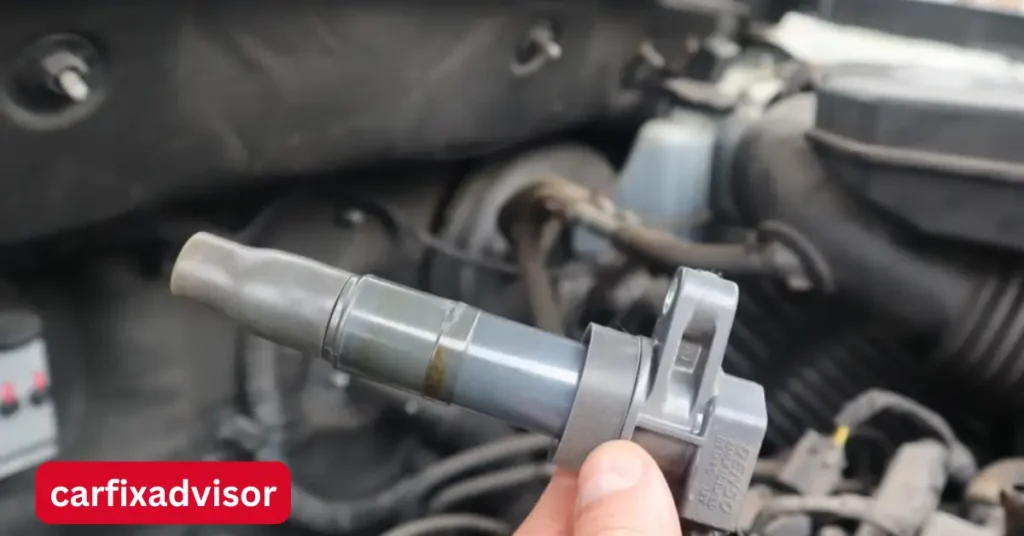Just changed your ignition coil? You’re not done yet. Knowing what to do after changing ignition coil is essential to ensure your vehicle runs efficiently and avoids engine misfires, warning lights, or hidden issues. Many car owners overlook important steps that should follow the replacement — and that leads to problems later on.
This guide walks you through exactly what to do after replacing ignition coil with a step-by-step checklist to avoid costly mistakes.
Why You Must Follow Steps After Changing Ignition Coil
Changing the ignition coil is a key repair, but it doesn’t fix everything. If you don’t know what to do after changing ignition coil, you may still face rough idling, check engine lights, or poor acceleration.
Key Terms to Know
Ignition Coil
A component that boosts voltage so your spark plugs can ignite the air-fuel mixture in your engine.
ECU (Engine Control Unit)
The car’s computer that controls ignition timing, air-fuel ratios, and emissions.
OBD-II Scanner
A handheld device used to read engine codes and reset warning lights.
Steps to Take After Changing Ignition Coil
Below is your essential checklist after ignition coil change — follow these steps in order to ensure your car runs properly and to prevent further engine issues.
1. Use an OBD-II Scanner to Clear Codes
● Plug in your scanner and check for old fault codes.
● Clear all codes related to misfires or ignition problems.
● Some auto parts stores offer free scanning and clearing services.
This step ensures the ECU doesn’t keep referencing outdated problems. It’s a vital part of what to do after changing ignition coil.
2. Reconnect the Battery (If Disconnected)
● Make sure the battery is connected properly.
● Double-check terminal tightness and cleanliness.
● Turn the ignition to ON, wait 10 seconds, then start the engine.
A full power cycle helps the ECU recalibrate to the new coil.
3. Start the Engine Cold
● Let the vehicle sit overnight.
● In the morning, perform a cold start and listen for unusual sounds.
● Misfires at startup may signal deeper ignition or fuel problems.
This cold-start test is one of the smartest post-ignition coil replacement steps.
4. Test Drive in Varied Conditions
Don’t just idle in your driveway. You must drive under real-world conditions:
● Cruise at highway speeds
● Accelerate quickly and slowly
● Climb hills to simulate engine load
● Brake and coast to a stop
Doing this helps uncover subtle issues the new coil alone may not fix.
Common Issues After Changing Ignition Coil
Many drivers still experience symptoms like misfiring or rough idling after installing a new coil. That’s why knowing what to do after changing ignition coil involves more than just turning the key.
| Issue After Coil Change | Possible Cause | What to Do Next |
|---|---|---|
| Still Misfiring | Bad spark plug or injector | Check spark plug gaps and fuel delivery |
| Check Engine Light Returns | New error code or incomplete reset | Rescan with OBD-II and re-clear codes |
| Rough Idling or Vibration | Vacuum leak or weak plug wires | Inspect hoses and ignition leads |
| Engine Hesitation or Stall | ECU adaptation not complete | Drive 20–30 miles to allow recalibration |
If your car still misfires after replacing the ignition coil, go through the checklist again. The fault could be elsewhere in the ignition or fuel system.
Inspect Connected Components Too
Replacing the coil is only one piece of the puzzle. The most overlooked part of what to do after replacing ignition coil is inspecting connected parts that may have also been damaged or degraded.
Key Items to Inspect
● Spark Plugs – Check for carbon buildup or improper gap
● Ignition Wires or Coil Boots – Cracks or arcing are common
● Fuel Injectors – Test for proper spray pattern
● Vacuum Lines – Leaks can mimic ignition problems
● Battery & Grounds – Weak voltage can reduce spark power
Resetting the ECU After Ignition Coil Replacement
One of the most overlooked yet critical post-ignition coil replacement steps is resetting your vehicle’s ECU (Engine Control Unit). If you don’t reset it, your engine might continue using old misfire data, which can trigger false check engine lights or poor performance.
How to Reset the ECU Properly
There are two common ways to reset the ECU after changing the ignition coil:
Method 1: Battery Disconnect Reset
-
Disconnect the negative terminal of the battery.
-
Wait at least 15–30 minutes.
-
Reconnect the battery and start the engine.
-
Let the engine idle for 10 minutes to allow relearning.
Method 2: OBD-II Tool ECU Reset
-
Connect an advanced OBD-II scanner.
-
Navigate to ECU Reset or Adaptive Reset.
-
Follow prompts to clear learned values.
-
Drive normally for at least 15–30 minutes.
These steps are essential when planning what to do after replacing ignition coil in modern vehicles that rely heavily on computerized control.
How to Test New Ignition Coil After Installation
Just because the engine starts doesn’t mean your new coil is working perfectly. You should always test it under different driving conditions.
| Test Type | What It Checks | When to Use |
|---|---|---|
| Idle Test | Basic functionality | Immediately after install |
| Acceleration Test | Coil performance under load | During low-to-high RPM transitions |
| Cruise Test | Consistency at steady speeds | On highway or flat roads |
| Scan Tool Test | Misfire data and coil voltage | For precise coil performance readings |
Knowing how to test a new ignition coil helps confirm whether the replacement solved the issue — or if there’s another fault lurking.
Break-in Period After Ignition Coil Replacement
There’s no formal “break-in” like with engine parts, but allowing your ECU to re-learn optimal settings is part of what to do after changing ignition coil.
What to Expect During the Relearning Phase
● Slight changes in idle speed
● Temporary increase in fuel consumption
● Minor hesitation during acceleration
● Idle surges or RPM fluctuations
These are normal during the first 50–100 miles of driving, especially if you’ve done a full ECU reset. If issues persist beyond that, revisit the checklist and test procedures.
Avoid These Mistakes After Replacing the Ignition Coil
Many car owners think replacing the ignition coil is a one-and-done fix. But skipping key follow-up steps can lead to:
Common Mistakes
● Not clearing old fault codes
● Ignoring worn spark plugs
● Skipping ECU reset
● Not testing coil under load
● Overlooking vacuum leaks
Knowing what to do after changing ignition coil means avoiding these traps that could cause misfires to return.

Should You Replace Spark Plugs Too?
A bad ignition coil often damages spark plugs, especially if the vehicle was misfiring for a while. That’s why many mechanics recommend replacing spark plugs at the same time — or soon after.
| Spark Plug Condition | What It Means | Action to Take |
|---|---|---|
| Black soot/carbon deposits | Running too rich, misfire history | Replace with properly gapped new plugs |
| White deposits | Running lean, possible overheating | Check fuel mixture and cooling system |
| Oil-fouled tips | Valve seal or ring wear | Address oil consumption before new plugs |
| Cracked insulator | Detonation or coil failure | Replace immediately with matching type |
Replacing the coil without checking the spark plugs is like changing a lightbulb but leaving a bad switch. That’s why it’s part of what to do after replacing ignition coil in a complete tune-up.
How to Prevent Future Ignition Coil Failures
After replacing the ignition coil, your goal should be to prevent it from failing again. A few proactive steps can save you time and money later. Here’s what commonly causes ignition coil issues.
Causes of Ignition Coil Failure
-
Worn spark plugs that increase coil workload
-
Oil or moisture getting into the coil area
-
Weak engine grounding or electrical problems
-
Engine overheating over long periods
-
Using cheap or low-quality replacement parts
Understanding these factors is important if you’re serious about knowing what to do after changing ignition coil and how to extend your engine’s lifespan.
Long-Term Maintenance After Replacing Ignition Coil
Routine maintenance matters. Once the new coil is in place, use these practices to support long-term engine health.
Maintenance Tips
-
Check spark plugs regularly and replace when worn
-
Keep ignition coil connectors dry and clean
-
Use dielectric grease on electrical connections
-
Watch for rough idling, misfires, or warning lights
-
Scan your vehicle occasionally with an OBD-II tool
These steps are essential for keeping your ignition system healthy after the replacement.
Final Checklist: What to Do After Replacing Ignition Coil
This checklist summarizes everything you should do after the coil change. It ensures you don’t miss key steps that affect performance.
| Task | Purpose | Best Time to Do It |
|---|---|---|
| Reconnect all wiring securely | Ensures proper coil function | Immediately after install |
| Test the ignition coil | Confirms successful installation | Before driving |
| Reset the ECU | Clears old error codes | After installation |
| Check and replace spark plugs | Reduces stress on new coil | Same day or within a few days |
| Monitor engine behavior | Detects misfires or stalling early | Over the first 100 miles |
| Run a code scan | Verifies no active fault codes | After first few drives |
Each item plays a role in the bigger picture of what to do after replacing ignition coil properly.
Conclusion
Changing your ignition coil is only part of the solution. Knowing what to do after changing ignition coil is critical for long-term engine health. From checking spark plugs to resetting the ECU, every small step matters.
With proper post-installation actions and ongoing maintenance, your engine will continue to run smoothly without future coil failures.
